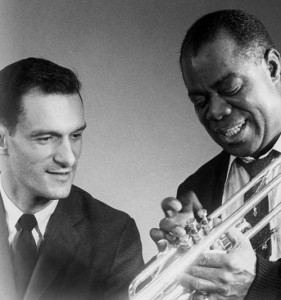 In today’s Wall Street Journal “Sightings” column I write about jazz as a cultural signifier—and how Hugh Hefner’s Playboy helped to shape that significance. Here’s an excerpt.
In today’s Wall Street Journal “Sightings” column I write about jazz as a cultural signifier—and how Hugh Hefner’s Playboy helped to shape that significance. Here’s an excerpt.
* * *
Contrary to popular belief, jazz wasn’t really born in the whorehouses of New Orleans. It was played there, though, and ever since then it’s been associated in the minds of many of its fans with the joys of sex….
No less noteworthy is the frequency with which jazz is now used in films and on TV as a musical signifier of world-weary hipness. It’s something I first noticed in 1993 when the Secret Service agent played by Clint Eastwood in “In the Line of Fire” turned out to be (like Eastwood himself) an amateur jazz pianist who listens to Miles Davis to unwind after spending the day chasing down assassins. What was true then is true today: Davis’ cooler-than-cool music is heard on the soundtrack of a recent series of car commercials in which Matthew McConaughey plays a super-suave gambler who drives to the big game in a Lincoln MKX.
Exactly how did jazz acquire this curious cultural cachet? I commend your attention to Playboy Swings!: How Hugh Hefner and Playboy Changed the Face of Music, a well-researched, fascinatingly detailed new book by Patty Farmer….
Mr. Hefner himself has described Playboy as “a lifestyle magazine that defined what it meant to be a [single] guy,” a slick monthly that published middle-to-highbrow essays and stories by writers like William F. Buckley Jr., Norman Mailer and Vladimir Nabokov (hence the once-ubiquitous catchphrase “I read it for the articles”) interspersed with pictures of naked women. Just as essential to its success, though, were the accompanying features that told its readers how to impress women as a preliminary step to bedding them. As the first issue proclaimed, “We like our apartment. We enjoy mixing up cocktails and an hors d’oeuvre or two, putting a little mood music on the phonograph and inviting in a female acquaintance for a quiet discussion on Picasso, Nietzsche, jazz, sex.”
 Note the strategic position of jazz in that list of topics. According to one of the magazine’s early editors, Playboy was designed to educate its naïve founder in the arcane ways of the bachelor hipster: “It told guys like him what movies to see, what books to read, how to dress…all the stuff that Hef himself didn’t know.” But Mr. Hefner did know one thing going in: He loved jazz, and he insisted that his magazine publish plenty of articles about the men who played it….
Note the strategic position of jazz in that list of topics. According to one of the magazine’s early editors, Playboy was designed to educate its naïve founder in the arcane ways of the bachelor hipster: “It told guys like him what movies to see, what books to read, how to dress…all the stuff that Hef himself didn’t know.” But Mr. Hefner did know one thing going in: He loved jazz, and he insisted that his magazine publish plenty of articles about the men who played it….
A lesser-known but identically revealing document of Mr. Hefner’s lifelong passion for jazz is “Playboy’s Penthouse,” the TV variety series that he hosted from 1959 to 1961. Purportedly taped in his own apartment (it was actually shot on a soundstage), the show featured such guests as Count Basie, Tony Bennett, Nat Cole, Ella Fitzgerald, Dizzy Gillespie and Mabel Mercer….
* * *
Read the whole thing here.
The first episode of Playboy’s Penthouse, taped in Chicago in 1959:
“The Winning Hand,” a commercial for the Lincoln MKX directed by Gus Van Sant. The music on the soundtrack is an excerpt from Miles Davis’ improvised score for Louis Malle’s film Elevator to the Gallows:
